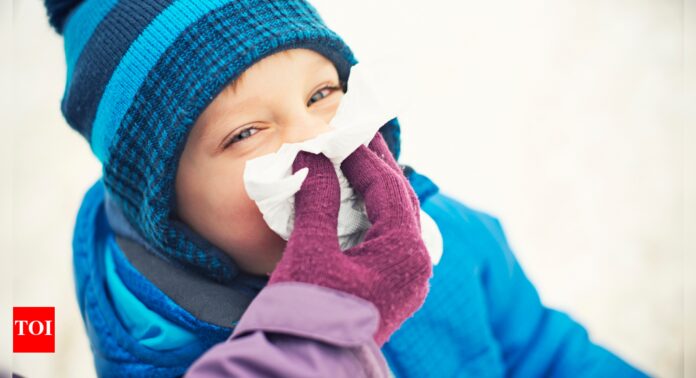With the winter season almost upon us, a familiar pattern begins to unfold: Sniffles, colds, coughs, and a dramatic rise in respiratory infections. The sudden drop in temperature makes the air dry, and both our bodies and the viruses around us respond in ways that make illness more likely. But why does this happen every year? The answer lies in the invisible effects of cold and dry air on our respiratory system, and how these conditions tip the balance in favor of viruses.
The compromised immune barrier

To begin with, cold air acts directly on our body’s natural defense system. The work of the researchers at Mass Eye and Ear and Northeastern University identified a recently found immune response in the nose that combats viral infections. As the nasal temperature decreased from that of normal human body temperature (~37 °C) to ~32 °C, this response slowed down dramatically, minimizing the function of cells to release antiviral signals.In other words, when cold air is inhaled, the nasal mucosa chills, blood flow narrows, and immune cells respond more slowly. Studies indicate that exposure to cold air, surface cooling, or even a small drop in core body temperature can increase the risk of infection.Therefore, our initial defense line, the nose and throat mucous membranes, functions less effectively to shield against entering viruses when exposed to cold.
The role of dryness

Cold air contains less moisture than warm air. Inside, when outside air is warmed up, relative humidity tends to drop to 20 % or below.Low humidity has several effects:One, the mucus film in the respiratory tract thins and becomes more viscous, thereby decreasing its capacity to capture and eliminate microbes. Dry air, as per Cleveland Clinic experts, makes the mucus “less effective trap for germs”. Two, low humidity favors the increased survival of several respiratory viruses. For example, a study demonstrated in PubMed Central, on the spread of the influenza virus on guinea pigs, explained that the virus spread best in dry air (20-35% RH) and survived longer under low-humidity and low-temperature conditions. In conclusion, it was stated that this experiment proved that cold and dry environments make influenza viruses spread easily through the air. Cold and dry air, together, create a ‘double-whammy’: A compromised barrier and a more formidable foe.
How viruses survive in winter

Winter conditions help viruses survive and spread in several ways:One, virus-containing droplets inhaled into the air do not evaporate or settle as rapidly in dry conditions, which allows them to be suspended for longer and carried further. Two, numerous respiratory viruses grow more efficiently at lower temperatures. It has been determined that rhinoviruses, for instance, grow more effectively under cooler conditions within the nasal cavities. Moreover, the depressed immune responses at lower temperatures make the virus face less resistance in becoming established. The studies outlined above directly associate lower nasal temperature with diminished antiviral responses.All these make infection more probable and account for why influenza, common cold and other respiratory ailments reach peak during winter.
Indoor behaviour and environment enhance the risk
Beyond physiology and physics, behavioural and environmental factors in winter amplify the risk. People spend more time indoors with closed rooms, and warm heating leads to drier indoor air, and buildings may recirculate air, increasing the chance of airborne virus buildup. In short, the indoor climate during winter often becomes favourable for virus survival and spread, while our personal defences are at a low ebb. According to research in NIH, under the title Indoor environment and viral infections, it stated that, indoor environment impacts viral infections through temperature, humidity, ventilation, air pollutants, surface contamination, and contact
Practical implications and preventive steps
Knowledge of these mechanisms assists in the development of preventive measures. The following are simple steps:Regulate indoor relative humidity at approximately 40-60 % if possible. This maintains healthy mucous membranes and minimizes virus survival odds. As moderate indoor relative humidity may minimise transmission of some viruses and maximise immune function, stated in research done by the National Institute of Health.Warm incoming cold air prior to deep inhalation, cover nose and mouth when outside in freezing air to reduce sudden cooling of the nasal cavity.Maintain good ventilation even with heating on—fresh air exchange minimizes virus-laden aerosol buildup.Drink plenty of water and have good overall health. Remember, a healthy mucosa and immune system minimize the risk of infection.Practice hygiene and avoid populated indoor areas when possible, particularly where humidity is low and occupancy is high.Winter’s cold, dry air increases our vulnerability to respiratory infections by a combination of compromised mucosal immunity, augmented virus survival, and indoor environmental conditions conducive to transmission.The science is clear: lower temperatures dampen our nasal antiviral response, dry air compromises mucous defence and allows viruses to survive longer, and indoor behavior transmits them. By understanding the science behind these mechanisms, one can make smart choices and changes such as modifying humidity, ventilation and personal protection, that substantially lower our risk of any kind of winter illnesses.


